Journal list menu
Export Citations
Download PDFs
Cover Pictures
Cover Picture: 3-Aminodeoxypyranoses in Glycosylation: Diversity-Oriented Synthesis and Assembly in Oligosaccharides (Angew. Chem. Int. Ed. 19/2017)
- Page: 5133
- First Published: 29 March 2017

Tetrasaccharides containing different 3-aminosugar components have been assembled by diversity-oriented synthesis and Yu glycosylation reactions. In their Communication on page 5227 ff., J. Zeng, Q. Wan, and co-workers describe a new type of key intermediate that provides access to naturally occurring 3-aminosugars and analogues thereof. These aminosugars were used in glycosylation reactions and should find applications in drug discovery.
Inside Cover: Efficient Palladium-Catalyzed Alkoxycarbonylation of Bulk Industrial Olefins Using Ferrocenyl Phosphine Ligands (Angew. Chem. Int. Ed. 19/2017)
- Page: 5134
- First Published: 07 April 2017

Game-changing ligand design for alkene alkoxycarbonylations: In their Communication on page 5267 ff., M. Beller and co-workers present a novel class of ferrocenyl ligands for improved alkene carbonylations. These phosphines with sterically hindered and amphoteric groups on the P atoms actively take part in the catalysis. They are easily synthesized and display higher activity and durability in alkoxycarbonylations of bulk olefins under milder conditions.
Inside Back Cover: Synthesis of Poly(arylene vinylene)s with Different End Groups by Combining Acyclic Diene Metathesis Polymerization with Wittig-type Couplings (Angew. Chem. Int. Ed. 19/2017)
- Page: 5369
- First Published: 05 April 2017
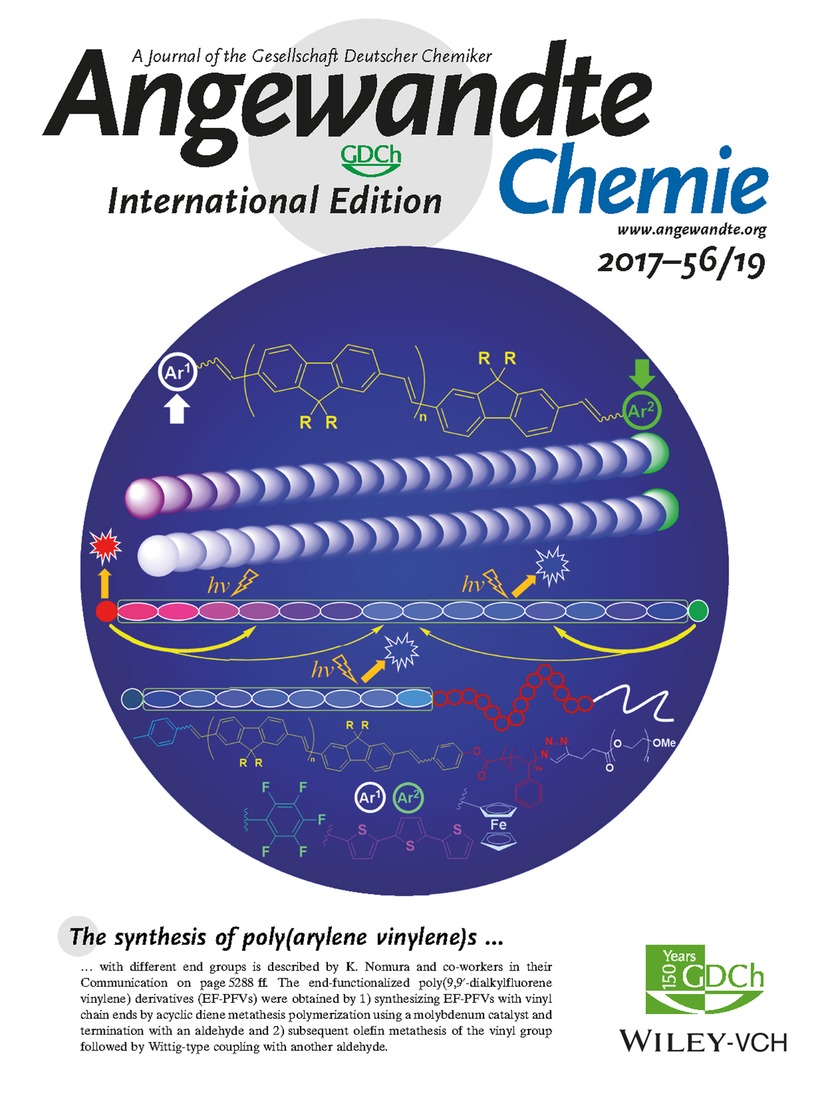
The synthesis of poly(arylene vinylene)s with different end groups is described by K. Nomura and co-workers in their Communication on page 5288 ff. The end-functionalized poly(9,9′-dialkylfluorene vinylene) derivatives (EF-PFVs) were obtained by 1) synthesizing EF-PFVs with vinyl chain ends by acyclic diene metathesis polymerization using a molybdenum catalyst and termination with an aldehyde and 2) subsequent olefin metathesis of the vinyl group followed by Wittig-type coupling with another aldehyde.
Back Cover: Formation of an Isolable Divinylborinium Ion through Twofold 1,2-Carboboration between a Diarylborinium Ion and Diphenylacetylene (Angew. Chem. Int. Ed. 19/2017)
- Page: 5370
- First Published: 04 April 2017
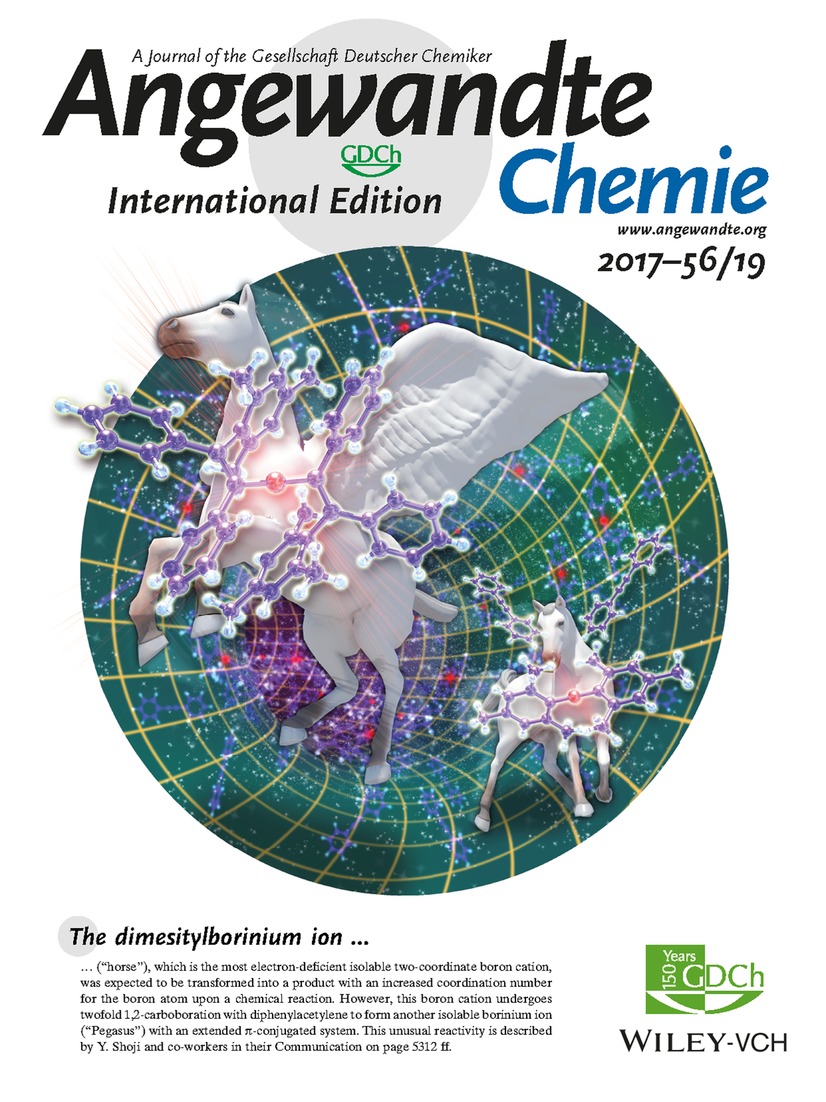
The dimesitylborinium ion (“horse”), which is the most electron-deficient isolable two-coordinate boron cation, was expected to be transformed into a product with an increased coordination number for the boron atom upon a chemical reaction. However, this boron cation undergoes twofold 1,2-carboboration with diphenylacetylene to form another isolable borinium ion (“Pegasus”) with an extended π-conjugated system. This unusual reactivity is described by Y. Shoji and co-workers in their Communication on page 5312 ff.
Frontispiece
Frontispiece: Mutant Exon1 Huntingtin Aggregation is Regulated by T3 Phosphorylation-Induced Structural Changes and Crosstalk between T3 Phosphorylation and Acetylation at K6
- First Published: 24 April 2017
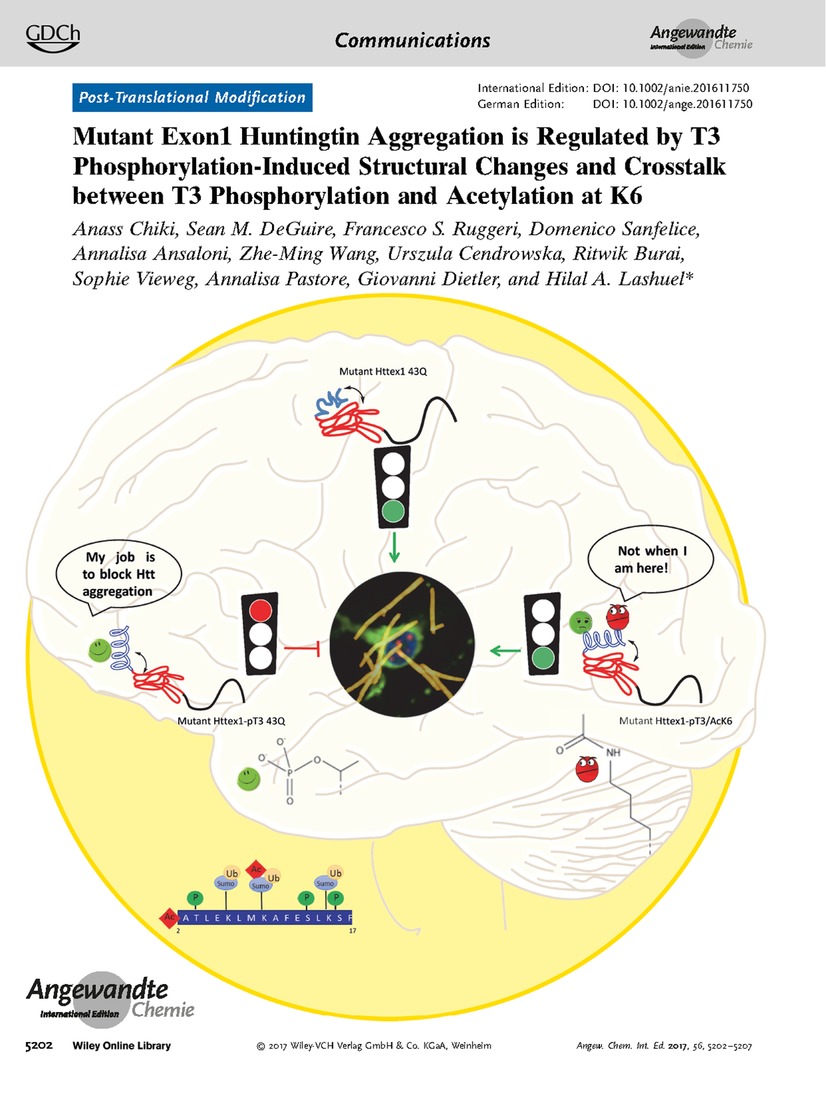
Huntington's Disease In their Communication on page 5202 ff. H. A. Lashuel et al. use protein semisynthesis to investigate the effect of lysine acetylation and phosphorylation on the aggregation of mutant huntingtin exon1. While phosphorylation significantly inhibits the aggregation, acetylation has no effect.
Graphical Abstract
Graphical Abstract: Angew. Chem. Int. Ed. 19/2017
- Pages: 5137-5147
- First Published: 24 April 2017
News
Spotlights on our sister journals: Angew. Chem. Int. Ed. 19/2017
- Pages: 5148-5151
- First Published: 24 April 2017
Author Profile
News
Book Reviews
From Biosynthesis to Total Synthesis. Strategies and Tactics for Natural Products. Edited by Alexandros L. Zografos.
- Pages: 5155-5156
- First Published: 29 March 2017
Correspondence
Zeolite Nanosheet Synthesis (1)
On Layered Silicates and Zeolitic Nanosheets
- Pages: 5160-5163
- First Published: 05 April 2017

Zeolite synthesis: In a Communication published in this journal in early 2015, Messinger, Na, Seo, Ryoo, and Chmelka (MNSRC) claim that the formation of zeolite MFI nanosheets proceeds through an intermediate, crystalline layered silicate phase. It is now proposed that the layered silicate phase in the MNSRC work is an artefact rather than a species possibly playing a significant role in MFI nanosheet formation.
Zeolite Nanosheet Synthesis (2)
Non-Topotactic Transformation of Silicate Nanolayers into Mesostructured MFI Zeolite Frameworks During Crystallization
- Pages: 5164-5169
- First Published: 05 April 2017
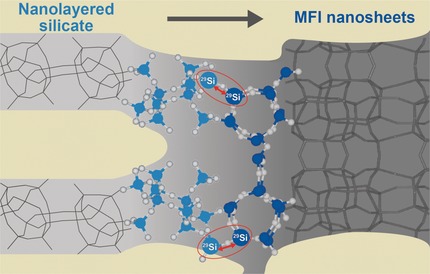
Mesostructured MFI zeolite nanosheets are established to crystallize non-topotactically through a nanolayered silicate intermediate during hydrothermal synthesis. Solid-state 2D NMR analyses, with sensitivity enhanced by dynamic nuclear polarization (DNP), provide direct evidence of shared covalent 29Si-O-29Si bonds between intermediate nanolayered silicate moieties and the crystallizing MFI zeolite nanosheet framework.
Minireviews
Transition-Metal Catalysis
Carbon–Carbon Bond Formation in a Weak Ligand Field: Leveraging Open-Shell First-Row Transition-Metal Catalysts
- Pages: 5170-5181
- First Published: 12 January 2017
Reviews
Biomolecule Functionalization
Methyltransferase-Directed Labeling of Biomolecules and its Applications
- Pages: 5182-5200
- First Published: 12 December 2016

Enzymatic methylation by methyltransferases (MTases) is an important biological process, and most MTases use the cofactor S-adenosyl-l-Methionine (AdoMet) as a methyl source. This Review summarizes the use of AdoMet-dependent MTases and AdoMet analogues for the transalkylation of various biomolecules. Different AdoMet analogues and their application to the functionalization of DNA, RNA, and proteins will be discussed.
Communications
Post-Translational Modification
Mutant Exon1 Huntingtin Aggregation is Regulated by T3 Phosphorylation-Induced Structural Changes and Crosstalk between T3 Phosphorylation and Acetylation at K6
- Pages: 5202-5207
- First Published: 23 March 2017
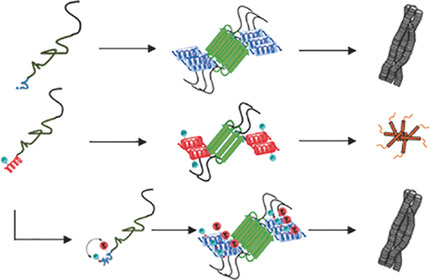
Protein semisynthesis was used to investigate the effect of lysine acetylation and phosphorylation, as well as the crosstalk between these modifications on the structure and aggregation of mutant huntingtin exon1 (Httex1). While phosphorylation significantly inhibits the aggregation of Httext1, acetylation has no effect. However, acetylation at K6 reverses the inhibitory effect of T3 phosphorylation.
NMR Spectroscopy
Fast NMR-Based Determination of the 3D Structure of the Binding Site of Protein–Ligand Complexes with Weak Affinity Binders
- Pages: 5208-5211
- First Published: 07 April 2017
Cooperative Catalysis
Asymmetric [4+2] Annulation of C1 Ammonium Enolates with Copper-Allenylidenes
- Pages: 5212-5216
- First Published: 31 March 2017
Frustrated Lewis Pairs | Hot Paper
Auto-Tandem Catalysis with Frustrated Lewis Pairs for Reductive Etherification of Aldehydes and Ketones
- Pages: 5217-5221
- First Published: 05 April 2017
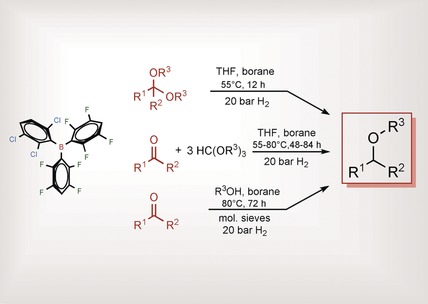
Double success: A metal-free reductive etherification method using frustrated-Lewis-pair-promoted reduction reactions of carbonyl compounds was developed. The key to success was the deliberate application of recently discovered water-tolerant frustrated Lewis pairs. The developments can be viewed as a double success in FLP catalysis and formation of ether bonds.
Heterocycle Synthesis
Associative Covalent Relay: An Oxadiazolone Strategy for Rhodium(III)-Catalyzed Synthesis of Primary Pyridinylamines
- Pages: 5222-5226
- First Published: 05 April 2017

A relay formalism is proposed herein for categorizing the interplay among reactants, target product, and catalytic center in transition-metal catalysis, an important factor dictating the overall reaction viability and efficiency. An intriguing associative covalent relay process in RhIII-catalyzed oxadiazolone-directed alkenyl C−H coupling with alkynes enables efficient access to primary pyridinylamines.
Glycosylation
3-Aminodeoxypyranoses in Glycosylation: Diversity-Oriented Synthesis and Assembly in Oligosaccharides
- Pages: 5227-5231
- First Published: 20 March 2017

A diversity-oriented approach for the synthesis of naturally occurring 3-amino- and 3-nitro-2,3,6-trideoxypyranose derivatives from simple sugars has been developed. These studies led to the successful synthesis of a tetrasaccharide containing four different 3-aminosugar components by stereoselective glycosylation of ortho-alkynylbenzoate donors.
Porous Films
Constructing Mie-Scattering Porous Interface-Fused Perovskite Films to Synergistically Boost Light Harvesting and Carrier Transport
- Pages: 5232-5236
- First Published: 07 April 2017

All about Mie: All-inorganic perovskite films with a porous interface-fused structure are formed by freeze-drying. Mie scattering and interconnection occurring in the porous films significantly enhanced the light harvesting and charge transporting ability. The Mie porous perovskite photodetectors possess a high on/off ratio of more than 104 and the peak external quantum efficiency value of 658 % with a bias of 9 V at 520 nm.
Nanostructures
A Molecular Propeller with Three Nanohoop Blades: Synthesis, Characterization, and Solid-State Packing
- Pages: 5237-5241
- First Published: 04 April 2017

Nanohoops propel ahead: A triptycene-based molecular propeller with three nanohoop blades was synthesized by a three-fold intramolecular bisboronate homocoupling and subsequent reductive aromatization. Such nanopropeller molecules pack into a lamellar hexagonal structure with 11 Å-diameter channels that run perpendicularly to the layers.
Natural Products
Asperflavipine A: A Cytochalasan Heterotetramer Uniquely Defined by a Highly Complex Tetradecacyclic Ring System from Aspergillus flavipes QCS12
- Pages: 5242-5246
- First Published: 05 April 2017

The height of sophistication: Asperflavipine A (1), an unprecedented cytochalasan heterotetramer uniquely defined by 5/6/11/5/6/5/6/5/6/5/5/11/6/5 fused tetradecacyclic rings, was isolated from Aspergillus flavipes QCS12 along with a cytochalasan heterotrimer, asperflavipine B. Compound 1 showed moderate cytotoxicity and induced apoptosis in Jurkat, NB4, and HL60 cells through the activation of caspase-3 and degradation of PARP.
Analytical Methods
Subnanomolar Detection of Oligonucleotides through Templated Fluorogenic Reaction in Hydrogels: Controlling Diffusion to Improve Sensitivity
- Pages: 5247-5251
- First Published: 06 April 2017
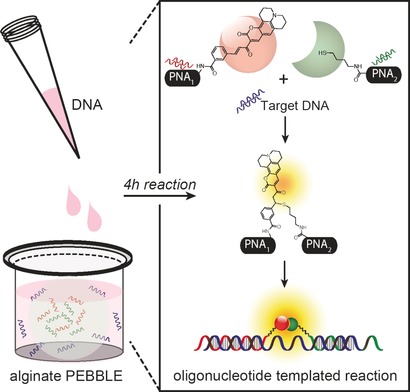
Nucleic acid hydrogel sensor: The subnanomolar detection of nucleic acid targets driven by an oligonucleotide-templated reaction between embedded fluorogenic peptide nucleic acid probes is demonstrated. Restricting probe diffusion in physically crosslinked hydrogels significantly increases the detection sensitivity by reducing non-specific reactions between probes in the absence of the target.
Glycoproteins
Synthetic Glycoforms Reveal Carbohydrate-Dependent Bioactivity of Human Saposin D
- Pages: 5252-5257
- First Published: 05 April 2017

Lipid wrap: The main glycoforms of the hydrophobic lysosomal glycoprotein saposin D (SapD) were synthesized by native chemical ligation. In functional assays the lipid-binding properties of three SapD glycoforms S1–S3 were found to be affected by the sugar moiety of SapD and showed a dependency on the size and the type of N-glycan.
Supramolecular Chemistry
Direct Self-Assembly of a 2D and 3D Star of David
- Pages: 5258-5262
- First Published: 06 April 2017
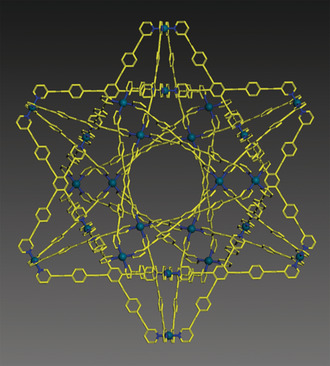
Stars within reach: Two- and three-dimensional metallosupramolecules shaped like a Star of David were synthesized by the self-assembly of a tetratopic pyridyl ligand with a 180° diplatinum(II) motif and PdII ions, respectively, in one step and high yield. The high stability of the 3D Star of David (see structure) is correlated to its high density of coordination sites.
Domino Arylation | Hot Paper
Domino N-/C-Arylation via In Situ Generation of a Directing Group: Atom-Efficient Arylation Using Diaryliodonium Salts
- Pages: 5263-5266
- First Published: 07 April 2017
Ligand Design
Efficient Palladium-Catalyzed Alkoxycarbonylation of Bulk Industrial Olefins Using Ferrocenyl Phosphine Ligands
- Pages: 5267-5271
- First Published: 30 March 2017
C−H Activation
Rhodium-Catalyzed meta-C−H Functionalization of Arenes
- Pages: 5272-5276
- First Published: 10 April 2017

Meta is a must: meta-C−H olefination of benzylsulfonic acid and phenyl acetic acid frameworks with the assistance of a para-methoxy-substituted cyano phenol as the directing group is achieved by Xphos-supported rhodium catalysis. Complete mono-selectivity is observed for both scaffolds. COD=1,5-cyclooctadiene, DCE=1,2-dichloroethane, TFA=trifluoroacetic acid.
Polymerization
Phosphasalen Indium Complexes Showing High Rates and Isoselectivities in rac-Lactide Polymerizations
- Pages: 5277-5282
- First Published: 05 April 2017
Proton Channels
Activation pH and Gating Dynamics of Influenza A M2 Proton Channel Revealed by Single-Molecule Spectroscopy
- Pages: 5283-5287
- First Published: 04 April 2017
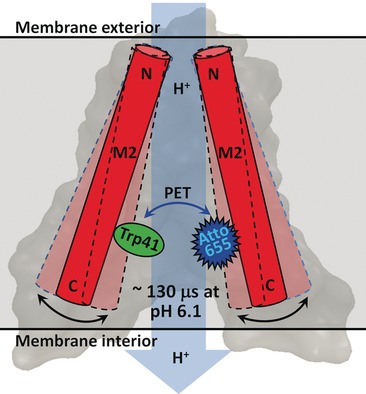
Motion of the gate: The Trp41 gate of the M2 proton channel is shown to undergo a spontaneous conformational motion on a timescale of tens to hundreds of microseconds. The time constant of this motion exhibits a sigmoidal dependence on pH with a midpoint that closely matches the electrophysiologically determined conducting pKa value of the His37 tetrad, suggesting that this motion accompanies proton conduction.
Polymers
Synthesis of Poly(arylene vinylene)s with Different End Groups by Combining Acyclic Diene Metathesis Polymerization with Wittig-type Couplings
- Pages: 5288-5293
- First Published: 24 March 2017
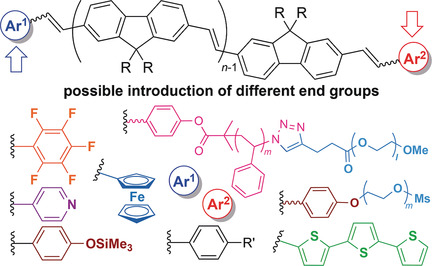
Which is the end? Conjugated polymers based on poly(9,9′-di-n-octylfluorene vinylene) with different end groups were synthesized by combining molybdenum-catalyzed acyclic diene metathesis polymerization with a subsequent Wittig-type coupling. Their fluorescence spectra were influenced by the end groups and the conjugation length.
Artificial Ion Channels
Temperature-Sensitive Artificial Channels through Pillar[5]arene-based Host–Guest Interactions
- Pages: 5294-5298
- First Published: 06 April 2017
Photocatalysis
Topotactic Epitaxy of SrTiO3 Mesocrystal Superstructures with Anisotropic Construction for Efficient Overall Water Splitting
- Pages: 5299-5303
- First Published: 06 April 2017
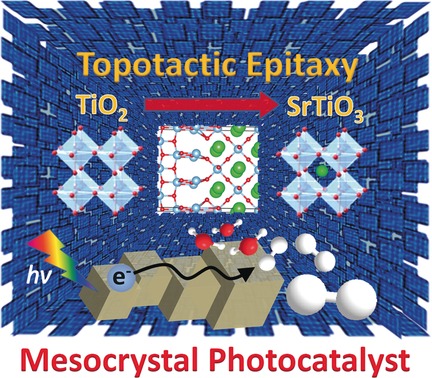
SrTiO3 mesocrystal superstructures were facilely synthesized by newly developed topotactic epitaxy from TiO2 mesocrystals by a simple hydrothermal treatment. The synergy of the efficient electron flow along the internal SrTiO3 nanocube network and efficient collection at the larger external cubes produces remarkably long-lived charges for enhanced photocatalysis.
Biocatalysis
Intramolecular Benzoin Reaction Catalyzed by Benzaldehyde Lyase from Pseudomonas Fluorescens Biovar I
- Pages: 5304-5307
- First Published: 07 April 2017
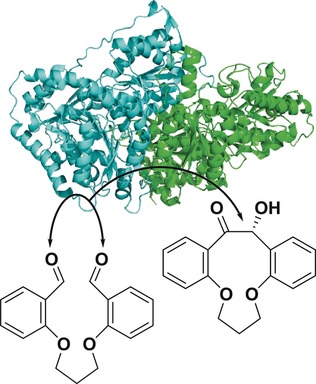
Let's play BAL(L): Benzaldehyde lyase from Pseudomonas fluorescens biovar I (BAL) can catalyze enantioselective intramolecular benzoin reactions. The structural requirements for the substrate include two benzaldehyde moieties, with or without additional substituents at the 3,3′ and 5,5′ positions of the rings, connected by ether bonds to a C3 linker at the 2,2′ positions. The synthesis of non-natural macrocycles is now possible through this biocatalytic route.
Photosynthesis
Conjugated Polymer Nanoparticles to Augment Photosynthesis of Chloroplasts
- Pages: 5308-5311
- First Published: 05 April 2017
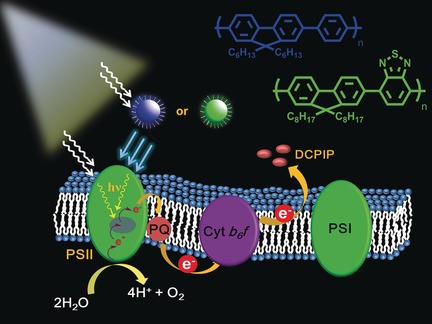
A new bio-optical hybrid photosynthesis system is developed by coating chloroplasts with conjugated polymer nanoparticles (CPNs). Since CPNs can harvest ultraviolet light that chloroplasts absorb less, chloroplast/CPN complexes capture a broader range of light to accelerate electron transport rates in photosystem II (PS II) and augment photosynthesis beyond natural chloroplasts. DCPIP=2,6-dichlorophenolindophenol dye, PQ=plastoquinone.
Boron Compounds
Formation of an Isolable Divinylborinium Ion through Twofold 1,2-Carboboration between a Diarylborinium Ion and Diphenylacetylene
- Pages: 5312-5316
- First Published: 30 March 2017

Still hungry: A two-coordinate diarylborinium ion undergoes twofold 1,2-carboboration with two equivalents of diphenylacetylene to form an unprecedented divinylborinium ion. NMR spectroscopy and X-ray diffraction analysis, together with theoretical calculations, revealed that the positive charge of the divinylborinium ion is delocalized over the entire π-conjugated system.
C−H Activation
Copper-Mediated Late-Stage Functionalization of Heterocycle-Containing Molecules
- Pages: 5317-5321
- First Published: 10 April 2017
Asymmetric Catalysis
Chiral Brønsted Acid-Catalyzed Asymmetric Synthesis of N-Aryl-cis-aziridine Carboxylate Esters
- Pages: 5322-5326
- First Published: 05 April 2017

Nice and easy: An efficient one-pot synthesis of chiral non-racemic aziridines was achieved by using 1 mol % of a readily available Brønsted acid catalyst. The introduction of an ortho-tert-butoxy group on the N-aryl ring was critical to inducing high levels of optical activity in the products. By using this protocol a simple 4-step synthesis of the antibiotic (+)-chloramphenicol was realized.
Biosynthetic Intermediates
Synthesis and Identification of Key Biosynthetic Intermediates for the Formation of the Tricyclic Skeleton of Saxitoxin
- Pages: 5327-5331
- First Published: 31 March 2017
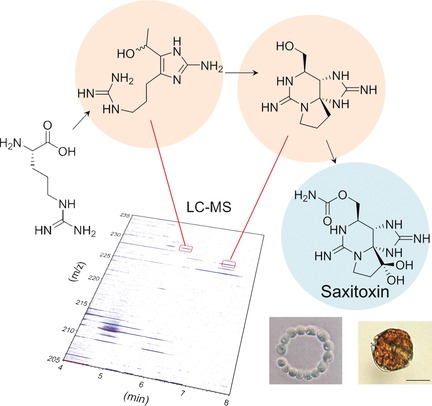
Skeleton key: Intermediates in early stages of the biosynthesis of saxitoxin have been identified through a combination of LC-MS and synthesis. Incorporation experiments with 15N-labeled compounds have shown that these previously proposed intermediates are key precursors of the potent voltage-gated sodium channel blocker. A mechanism for the formation of the tricyclic skeleton of saxitoxin is also put forward.
Spiro-Compounds
Efficient Catalytic Kinetic Resolution of Spiro-epoxyoxindoles with Concomitant Asymmetric Friedel–Crafts Alkylation of Indoles
- Pages: 5332-5335
- First Published: 05 April 2017

Crafty: An efficient process involving the catalytic kinetic resolution of racemic spiro-epoxyoxindoles with the simultaneous enantioselective Friedel–Crafts alkylation of indoles has been realized using a chiral phosphoric acid catalyst. The reaction provides two useful intermediates in high yields and excellent enantioselectivities. One of the intermediates was used in the asymmetric formal total synthesis of (+)-gliocladin C.
Asymmetric Catalysis
Enantioselective Palladium(II)-Catalyzed Intramolecular Aminoarylation of Alkenes by Dual N−H and Aryl C−H Bond Cleavage
- Pages: 5336-5340
- First Published: 07 April 2017
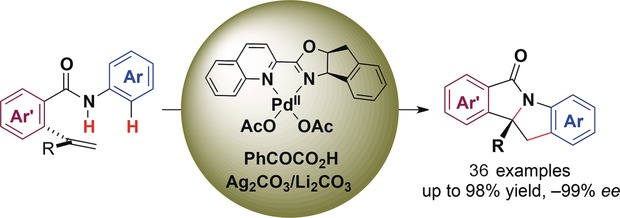
A neighborhood action group: In an asymmetric palladium-catalyzed intramolecular oxidative aminoarylation of alkenes in the presence of a quinolone–oxazoline chiral ligand and Ag2CO3 as the oxidant, the amide N−H bond of the substrate and a neighboring aryl C−H bond were both activated to react with the alkene (see scheme). Various indolines with a quaternary stereogenic center were synthesized in high yield with excellent enantioselectivity.
C−C Activation
Ruthenium(II)-Catalyzed C−C Arylations and Alkylations: Decarbamoylative C−C Functionalizations
- Pages: 5341-5344
- First Published: 05 April 2017
Enzyme Catalysis
Transforming a Stable Amide into a Highly Reactive One: Capturing the Essence of Enzymatic Catalysis
- Pages: 5345-5348
- First Published: 05 April 2017
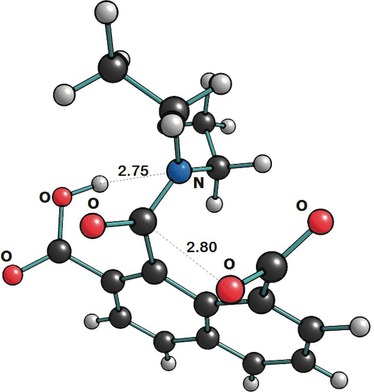
Solvent reorganization is not the sole source of enzymatic accelerations. As is shown in this Communication, two properly placed carboxy groups (see picture) can cause an otherwise nonactivated amide to cleave at enzymatic rates in the absence of any apparent solvent reorganization, thereby reaffirming spatiotemporal notions.
Protein Engineering
Proximity-Based Sortase-Mediated Ligation
- Pages: 5349-5352
- First Published: 04 April 2017

Proximity-based labeling: The poor reaction kinetics of sortase A (SrtA), a bacterial transpeptidase, has been a significant limitation for its use in site-specific protein bioconjugation. Proximity-based sortase-mediated ligation (PBSL) improves ligation efficiency by bringing target proteins in proximity to SrtA with the SpyTag–SpyCatcher peptide–protein pair and allows for protein purification and labeling to be simplified to a single step.
Biaryls
Copper-Mediated Decarboxylative Coupling of Benzamides with ortho-Nitrobenzoic Acids by Directed C−H Cleavage
- Pages: 5353-5357
- First Published: 10 April 2017

On Q: A copper-mediated decarboxylative coupling of benzamides with ortho-nitrobenzoic acids by a directed C−H cleavage proceeds to deliver the corresponding biaryls in good yields. The products can be readily transformed into various nitrogen-containing heterocycles. Additionally, a decarboxylative C−H arylation and cyclization sequence occurs, by adding a suitable base, to produce phenanthridinone derivatives in one pot.
Protein Engineering
Donor Promiscuity of a Thermostable Transketolase by Directed Evolution: Efficient Complementation of 1-Deoxy-d-xylulose-5-phosphate Synthase Activity
- Pages: 5358-5362
- First Published: 05 April 2017

Structure-guided engineering of a bacterial transketolase yielded enzyme variants capable of using aliphatic oxoacids as non-natural nucleophilic components for stereospecific acyloin synthesis. The double variant H102L/H474S showed high catalytic efficiency toward pyruvate and was able to complement a deletion of the dxs gene coding for 1-deoxyxylulose-5-phosphate synthase, which catalyzes the first step of the terpenoid biosynthesis.
Kinase Inhibitors
Optimized Target Residence Time: Type I Inhibitors for p38α MAP Kinase with Improved Binding Kinetics through Direct Interaction with the R-Spine
Inhibitors for p38α MAP Kinase with Improved Binding Kinetics through Direct Interaction with the R-Spine
- Pages: 5363-5367
- First Published: 11 April 2017
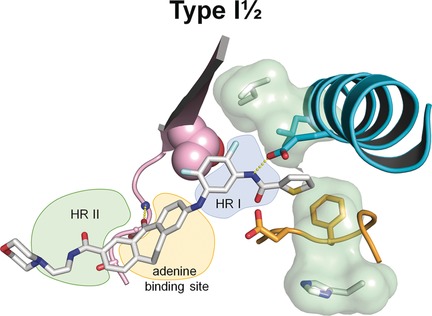
Staying power: A novel class of substituted dibenzosuberones combines high selectivity and potency in vitro with prolonged residence times and act as type I inhibitors of the enzyme p38α MAP kinase. The concept of the additional R-spine interaction was successfully transferred to the already very potent Skepinone-L scaffold.
inhibitors of the enzyme p38α MAP kinase. The concept of the additional R-spine interaction was successfully transferred to the already very potent Skepinone-L scaffold.




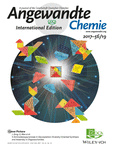
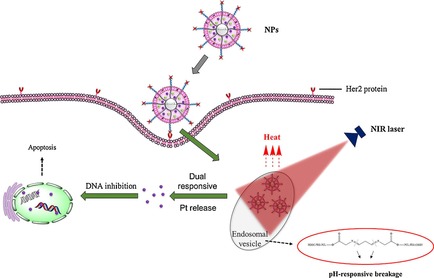
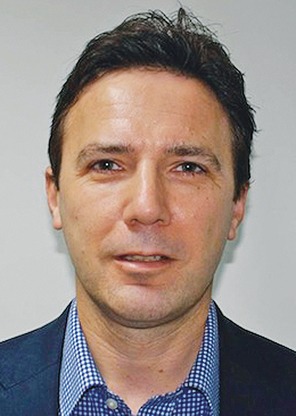
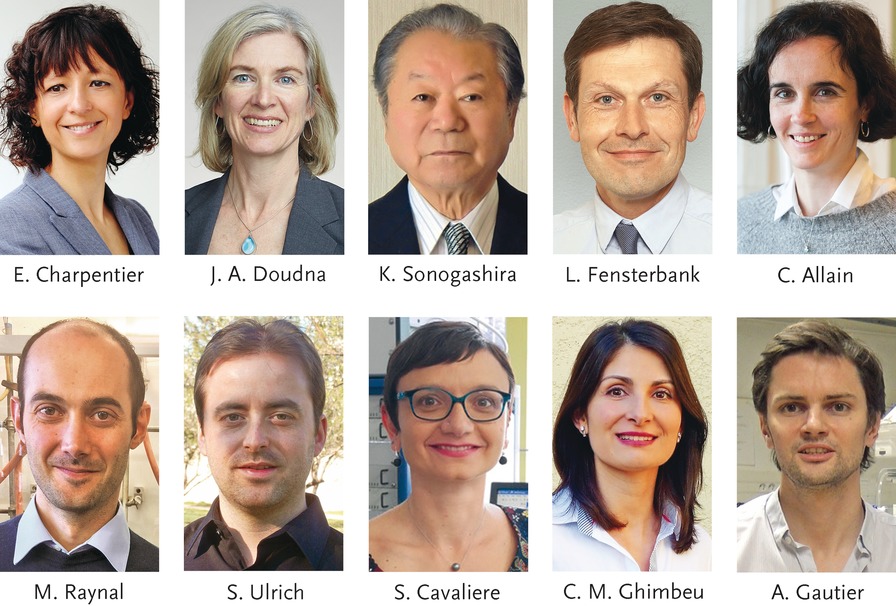
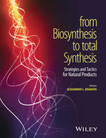
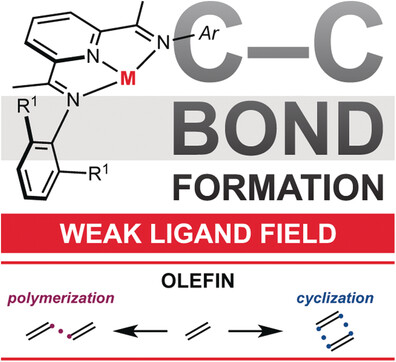
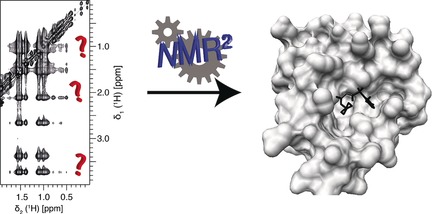
![Asymmetric [4+2] Annulation of C1 Ammonium Enolates with Copper-Allenylidenes](/cms/asset/87d15636-2057-481e-a37f-9fd641572b9d/anie201700105-toc-0001-m.jpg)
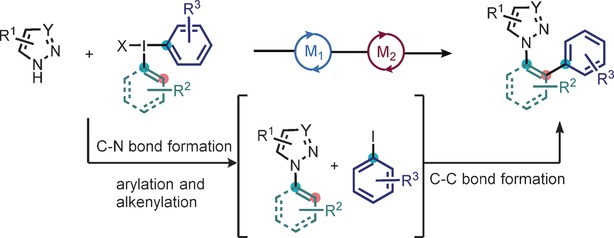

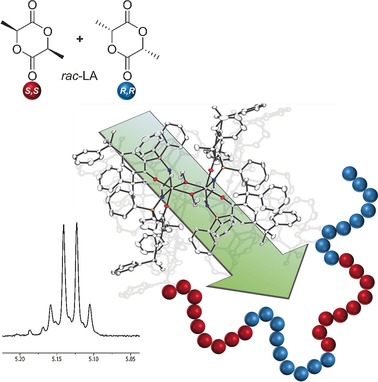
![Temperature-Sensitive Artificial Channels through Pillar[5]arene-based Host–Guest Interactions](/cms/asset/0a753c53-80ab-4af0-83ac-f2c7977f388a/anie201702175-toc-0001-m.jpg)




































